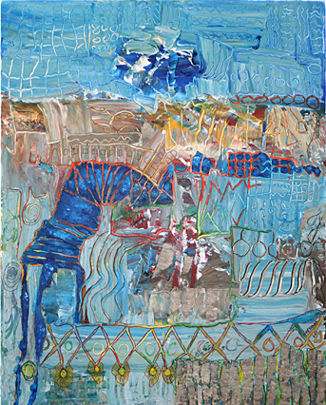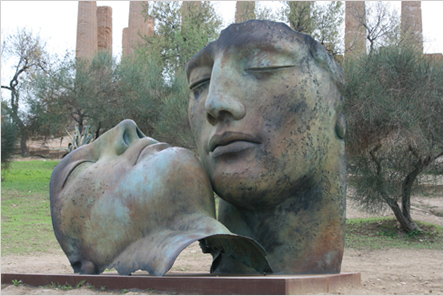The Perfect Venue
Dear Reader,
This month’s home page painting is called “The Return” because it is the result of my using paints after two years of working with ink drawings, transfers and very little paint (Judy’s Journal 2011 November). It felt great to be back in the mushy-gushy world of mixing paints.
 Artists exhibit their work in many different places. My work has been shown in galleries, museums, bookstores, libraries, cultural and community centers, historical sites, store fronts, a stage set, a television station, restaurants, a sandwich shop, and of course, this web site.
Artists exhibit their work in many different places. My work has been shown in galleries, museums, bookstores, libraries, cultural and community centers, historical sites, store fronts, a stage set, a television station, restaurants, a sandwich shop, and of course, this web site.
Traditional and alternative venues both serve one purpose: to get art “out there” in the hope that people will come to look at it! Soon, I may be able to add another alternative venue to the list. Berge Zobian, owner of Gallery Z in Providence, Rhode Island, has fund-raised his brilliant vision of an ArtMobile into reality. His concept involves “bringing fine art to the streets of Providence and beyond,” using a renovated FedEx truck as an art-space in motion (www.galleryzprov.com). Kudos to you and your staff, Berge!
Art on wheels or inside walls. Is there such a thing as a “perfect” venue for an artist’s work?
I think there is, and I was fortunate enough to see it: the Valley of the Temples in Agrigento, Sicily, where the Greeks built a magnificent city in 500 B.C. Agrigento was declared a UNESCO world heritage site in 1997, and it would have been enough to walk through this extraordinary place.
However, the Sicilians went an extra mile. They mounted a contemporary sculpture exhibit among the ruins. Lucky me. Lucky Igor Mitoraj, the sculptor whose work was featured this year. I say he is lucky because he has had his work placed in the “perfect” venue. Why?
Igor Mitoraj (b. 1944, Polish, b. Germany) has created a series of classical figures in bronze. They are large and fit the looming restoration of the Valley of the Temples like fingers in a glove. Mitoraj does not simply recreate a statue of Icarus. His postmodern sensibility urges him to use his exacting version of each damaged and broken piece of a classical figure as an opportunity for inserting smaller surreal forms. A cut-out in the wing of Icarus, for example, reveals a small face peering through.
A viewer could take in all eighteen figures in one breathless walk, but Mitoraj invites us to linger and explore smaller figures that insinuate themselves onto the surfaces of his perfectly rendered mythological creatures. These are not sculptures that you can pass by, because you will miss the point of their genius. Perfectly situated among the temples in Agrigento, these sculptures have found the perfect venue. You could almost hear the spirits of the ancients applaud!

Hermanos 2010-Photograph by John Gaumond
